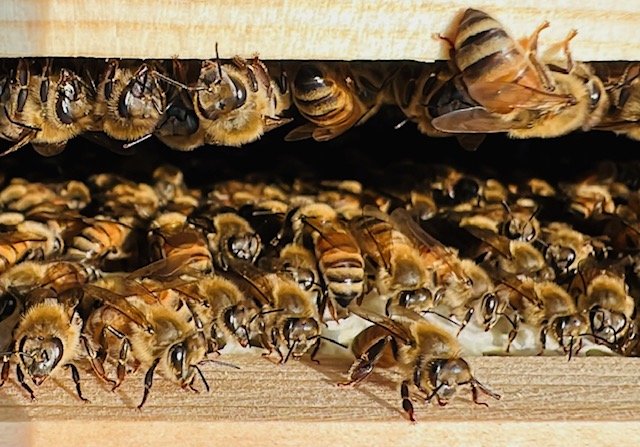Beekeeping: Becoming a Worker Bee
By Christie McGraw
Pictures by Tracy Niyo
Henry David Thoreau once said that the, “Keeping of bees is like the direction of sunbeams.”
Now imagine those sunbeams sting, have a hierarchy, overthrow one another, and have the ability to sense weakness. Tracy Niyo, a farm guide at Bowers Farm, has been diligently working at directing these buzzing sunbeams for the past year. She has taken a ten-month course, networked with fellow members of the beekeeping community, and furrowed her brow as she meticulously tended to her hive. Even saying “her” hive sounds wrong. It is the queen’s hive…until it’s not…
After months of studying, Tracy was ready to start her own hive down by the small pond that overlooks the community gardens. Options were presented to her. One of them was titled “Swarm Catching.” This sounds more like an intense reality show rather than real life. Swarm Catching involves getting an alert from someone in the beekeeper network that a swarm has been spotted. The eager new beekeeper would then rush to the site of the swarm. The swarm could be in a tree, an old abandoned cupboard, really anywhere bees find suitable. Once there, the person starts their hunt for the queen. The queen is bigger than her workers. Her wings look short because her body is long. Once she is caught, she is put into a “nuc box” for transport (“nuc” meaning the “nucleus” of the colony of bees). The queen then secretes pheromones that command the colony to follow her. Within a very short time, her entire swarm will follow her into the box. Spellbound, they commit to being captured.
In the end, Tracy chose to buy a “nuc” to start her hive. This seems like a wise move for a novice beekeeper.
To tend to bees, a person almost needs to become a bee. Tracy has, in many ways, become a worker bee. Worker bees spend their days tending. They are nurses to the queen. They monitor the stress level of the hive. They take inventory of resources and make tiny adjustments to promote thriving. They, in so many ways, try to direct sunbeams. In this endeavor, they are calculated, meticulous, and tidy. They are constantly cleaning up their hive home. They push the dead out through holes in the hive box. Tracy uses her bare hand to complete their act by whisking the dead away. Tracy adjusts too. A little sugar is placed on top of the frames in the hive to help supplement their bee diet in the harsh winter months. A little more insulation is added to protect the hive from the gusting wind. A little more studying. More collecting of evidence.
Even with the best possible efforts, things can deteriorate. A queen can become stressed by the condition of her hive. Worker bees are able to sense that tension and they start their planning. In the most cutting act of survival possible, they begin to grow a new queen. Royal jelly is produced and fed to the queen’s larvae. Soon, a new and more stable queen will emerge to command the colony. Thriving isn’t always a gentle process. In fact, it’s often quite the opposite.
During warmer days in the winter, Tracy opens the hive and puts her ear up next to her bees. She wants to hear that strong humming sound. Like a mom with a baby monitor, she leans in and assesses each wavering of the hum. The heartbeat of the hive. It’s a concrete way to know that, even though she can’t see all of them, they are safe. Her work has paid off.
Last summer, Tracy only got 12 ounces of honey for all of her buzzing about. This is typical for a starter hive. They, like us, need time to grow. Their energy is expended in search of stability, not glory. The real reward for Tracy is hearing that hum. It is in the thriving of this tiny society that she helped to engineer. In the end, she also gets the tangible satisfaction of pouring herself into something and walking away with a golden jar of honey in her hand. A jar the color of a sunbeam.






